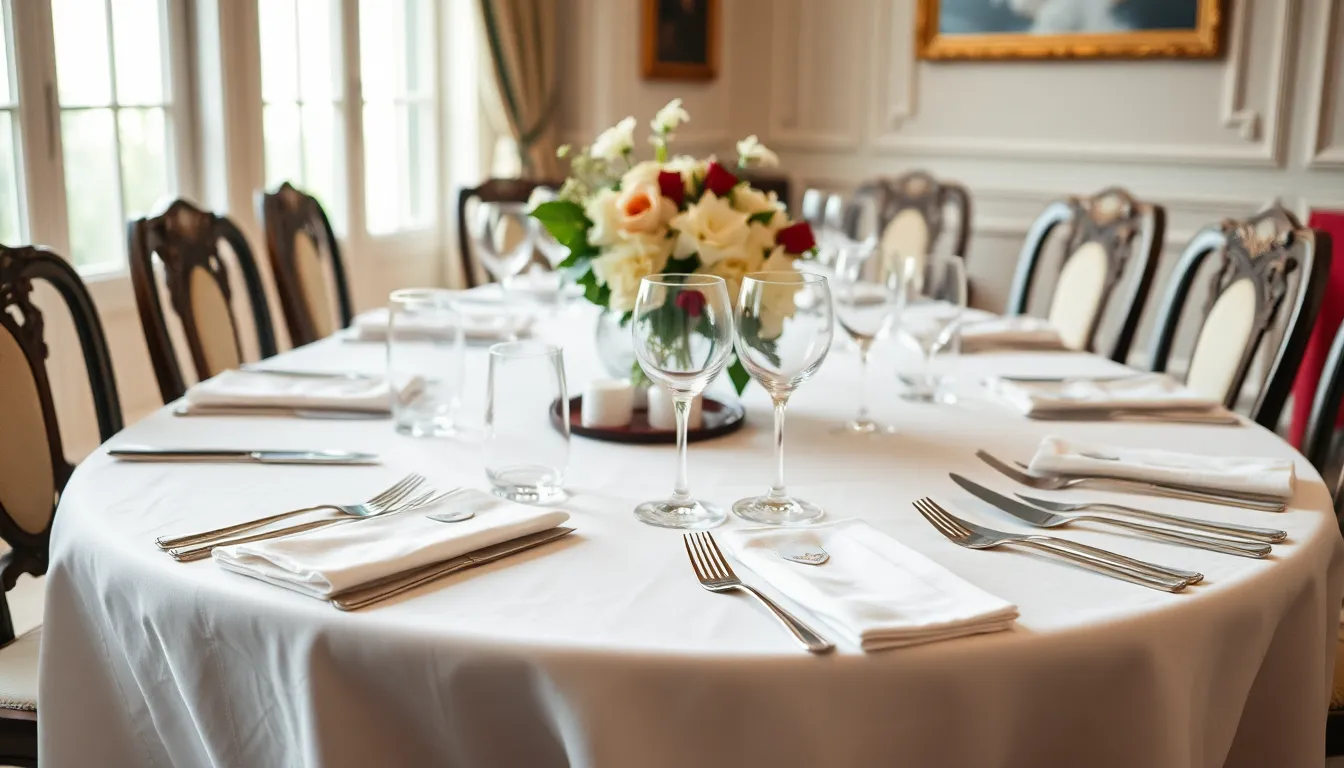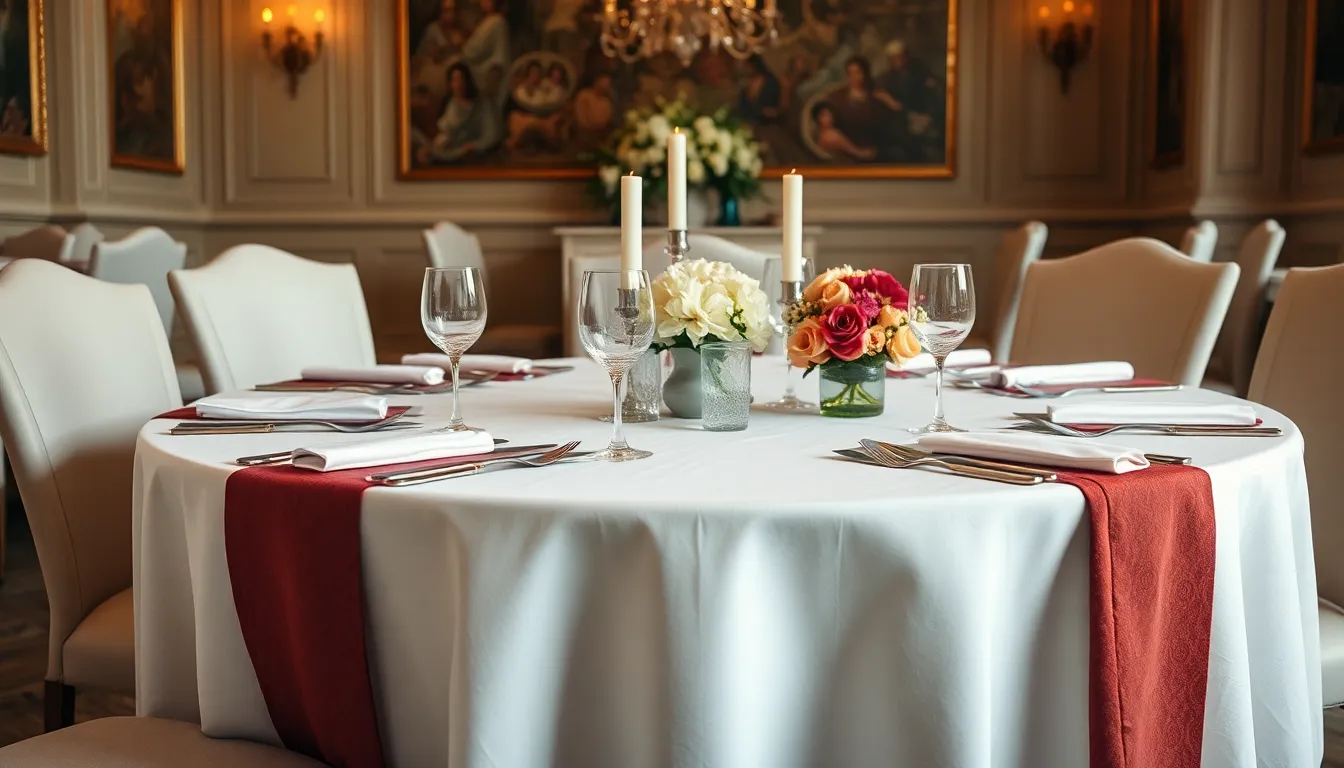Dining etiquette isn’t just about how to hold a fork; it’s the secret sauce that can turn a meal into a memorable experience. Imagine this: you’re at a fancy restaurant, and the waiter brings out a dish that looks like a work of art. But wait! The last thing you want is to accidentally use the salad fork for your main course and become the star of a cringe-worthy moment.
Mastering dining etiquette can save anyone from social faux pas and elevate their dining game. Whether it’s knowing which glass to raise for a toast or how to navigate a multi-course meal without looking like a deer in headlights, these skills can make all the difference. So grab your napkin and get ready to dive into the delightful world of dining etiquette, where the right moves can impress even the toughest critics.
Table of Contents
ToggleUnderstanding Dining Etiquette
Dining etiquette encompasses more than just utensil usage. Skills in this area enhance social interactions and prevent misunderstandings during meals.
Importance of Dining Etiquette
Mastering dining etiquette holds significant value in both social and professional settings. Firstly, it fosters a respectful environment among diners. Guests often appreciate attention to detail in manners and behaviors. Secondly, knowledge of etiquette gives confidence in various dining situations. When attending formal events, participants benefit from knowing appropriate behaviors. Lastly, understanding these norms impresses even discerning hosts who value hospitality.
Cultural Differences in Dining Norms
Cultural variations in dining norms illustrate the richness of global traditions. In many Asian countries, for instance, eating with chopsticks is preferred over Western utensils. Table manners can significantly differ between cultures, influencing perceptions of respect and dining enjoyment. Additionally, some cultures emphasize communal dining practices, encouraging sharing from common dishes. Others maintain strict rules about seating arrangements and meal timings. Familiarity with these differences fosters sensitivity and appreciation for diverse customs while dining.
Table Settings and Arrangements


Table settings and arrangements play a crucial role in dining etiquette. Understanding the differences between formal and informal settings enhances the dining experience.
Formal vs. Informal Settings
Formal dining sets require specific arrangements and etiquette. Utensils are placed according to the order of use, with forks positioned to the left and knives and spoons to the right. In contrast, informal settings allow for more flexibility in utensil placement. Guests often find a simpler arrangement with fewer utensils involved. Tablecloths, centerpieces, and glassware also differ. Formal dinners typically feature elegant tablecloths and elaborate centerpieces, while casual meals opt for simpler decorations.
Essential Dining Utensils
Essential dining utensils include forks, knives, spoons, and specialized implements. Forks come in various types, such as salad forks and dinner forks, each serving a distinct purpose. Knives, particularly dinner knives, should face the plate with the cutting edge inward. Spoons, including soup spoons and dessert spoons, provide further functionality at the table. Additionally, serving utensils like tongs and ladles play a key role in sharing dishes. Understanding their uses facilitates smooth dining interactions.
Behavior at the Table
Dining behavior significantly affects social interactions. Proper posture and conversational etiquette enhance the dining experience.
Proper Seating Posture
Maintaining an upright posture shows attentiveness and respect. Sit with back straight and feet flat on the floor or crossed at the ankles. Elbows should not rest on the table; keeping them close to the body is polite. Hold utensils correctly and avoid fidgeting in the chair. Leaning slightly forward when engaging in conversation indicates interest. It’s crucial to avoid slouching, as it may be perceived as disrespectful.
Conversational Etiquette
Engaging in conversation contributes greatly to the dining atmosphere. Start discussions by asking open-ended questions to encourage participation. Listen actively and respond thoughtfully to others’ comments. Avoid dominating the conversation; everyone should have a chance to contribute. Encourage all guests to engage, including those who may be quieter. Keep topics light and avoid sensitive issues like politics or religion. Additionally, monitor body language; maintain eye contact and nod to show understanding and connection.
Dining Etiquette in Different Cultures
Dining etiquette varies significantly across cultures. Understanding these nuances enhances the dining experience and fosters respect among diners.
American Dining Etiquette
American dining etiquette emphasizes casualness but maintains specific practices. Diners typically wait for the host to start eating. Utensil use follows a left-to-right pattern, with forks on the left and knives on the right. It’s polite to keep hands on the table, but elbows should remain off. Conversations should focus on light topics, avoiding politics or sensitive subjects. Guests should express appreciation for the meal, and acknowledging the host’s efforts is customary. Additionally, signaling for attention should occur discreetly, often with eye contact rather than raising a hand.
European Dining Etiquette
European dining etiquette varies by country but often includes formal customs. In many countries, such as France and Germany, starting the meal waits for everyone to be served. Utensil usage remains distinct, with continuous knife and fork handling. Diners may keep hands visible above the table but avoid elbows resting on it. Engaging in conversation throughout the meal is common, often requiring attentive listening. Tipping practices also differ; some countries include service charges, while others encourage rounding up the bill. Lastly, polite farewells to all attendees enhance social interactions while leaving the table.
Mastering dining etiquette is a valuable skill that can significantly enhance social and professional interactions. By understanding the nuances of table settings and cultural differences, individuals can navigate a variety of dining situations with ease. Proper posture and engaging conversation contribute to a respectful atmosphere that fosters connection among diners.
Being aware of etiquette not only prevents social blunders but also reflects a person’s attention to detail and respect for others. Whether in a formal or informal setting, these practices create memorable dining experiences that leave a lasting impression. Embracing dining etiquette is an investment in one’s social confidence and cultural appreciation.



